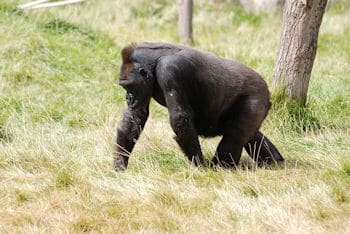Mountain Gorilla Safari in Africa’s Rain Forests Part 2
Mountain gorilla safari in Africa part 2
Uganda, Rwanda and Democratic Republic of the Congo (DRC), Which is the best destination for gorilla trekking?
Mountain gorilla safari in Africa can be difficult because the exact location of the mountain gorillas keeps shifting. The primates keep moving between the forests of Uganda, Rwanda and DRC. Tour operators select which tour based on the location of the gorilla population at the time of the safari. Tourists may find themselves trekking gorillas in either Uganda or Rwanda. Tour operators make the choice.
Primates keep moving within the parks. This causes mountain gorilla trekking to be a little tricky.
Mountain Gorilla Safari Family Group
Price differences in mountain gorilla safari
The disadvantage of choosing Rwanda is that its gorilla permit costs $1500 per person. Uganda only charges $600 for the permit. And in terms of costs, different tours in Rwanda and Uganda can be competitive. So one can find deals in either of the countries. Even though tourists may be able to get a better deal in Uganda on gorilla permits, they may find a less expensive operator out of Rwanda. One advantage of trekking in Rwanda is that the park is located near the Airport.
The gorilla permits in Uganda and options of seeing other wildlife
The main advantage of trekking in Uganda is the cheaper gorilla permit and the ability to mix gorilla trekking with other wildlife tours. Tourists can combine a gorilla trekking safari with other options. Such as Lake Bunyonyi, which is also close to Bwindi Park game viewing in Queen Elizabeth. As well as Chimpanzee trekking in Kibale National park, or bird viewing in Semliki. Included is mountain hiking on the Rwenzori Mountains and wildlife viewing in Murchison falls National Park.
The Distance in Driving and accessing the mountain gorillas
Travelers will find that Bwindi Forest National Park is not close to Entebbe International Airport, and this adds more expenses while traveling to the National Park in Uganda. Though the drive is long, it’s also scenic and gives good insights into the rural areas. The short drive in Rwanda is not as scenic as that of Uganda. For tourists who find the drive too long, then flying from Entebbe to Bwindi, and landing in the nearby towns of Kihihi and Kisoro is the best way to go. Aero link has the most affordable rates for domestic flights.
How to get to the mountain gorillas
Mountain gorillas are found deep within the forest in Uganda. The gorillas live in groups of about 10 to 20 individuals, with one silverback. Tourists trekking in Bwindi Park will find it more challenging as the mountain gorillas are not close to the entrance to the Park. Trekkers have to hike up a steep slope out of the forests to get back to their lodges or hotels. Eco tourists will find Rwanda‘s gorillas are close to the park entrance, which means shorter hikes. However, in Rwanda, trekkers can’t request a certain gorilla group to track, plus the group might shift inside the forest.
The political considerations as to which country to go to
Political stability is vital when deciding where to go gorilla trekking. This includes the local political conditions in the three countries and the availability of the gorilla permits.
Uganda is a stable and safe country after rebuilding itself after many years of conflict and unrest, especially in northern Uganda. Also traveling in southern part of the country is safe. Uganda as a whole is a peaceful country.
Rwanda is also politically stable, after recovering from the genocide that took place in the early 1990s. The Volcanoes National park is safe and well managed by Rwanda Development Board. Its gorilla permits are functional and effective.
In the Democratic Republic of the Congo the civil wars and conflicts are still a problem. Tourists need to check safety conditions before visiting this country. Militant groups and the army are still fighting in the Virunga area, where the mountain gorillas are located. Poachers are also a big threat to the gorilla population, as well as the poverty of the people near the National park. This all leads to habitat destruction. Many advisory organizations consider this area too volatile for travelers and therefore recommend tourists avoid touring the DRC. Tourists need to check traveler’s warnings or check with local tour companies, who will have a good idea how safe it is. The DRC is considered safer than it has been in a long time, but caution is still needed.
How does a typical gorilla safari work
Finding and getting to the mountain gorillas in their natural habitat is not easy as people think, nor are the trekkers guaranteed to see them. The trek looking for mountain gorillas will take trekkers through very dense vegetation, and along the narrow trails with muddy, as well as steep slopes. Searching for the primates can take many hours since the mountain gorillas keep moving around in the thick undergrowth that shifts deep into the forest. Once the gorillas are found, they are wonderful to visitors since they are used to the human presence.
Beginning the gorilla safari
Tracking the mountain gorillas starts early in the morning. First driving to the boundary of the park for the general formalities, then proceeding to the ranger’s station. The safari cars are left behind at the ranger station and tourists walk from there. The group follows instructions of the local ranger through farmland and into the thick vegetation of Bwindi Forest National Park.
What to know about your mountain gorilla safari
A group of gorillas is called a whoop. The rangers will tell visitors about the family of the gorillas they are tracking. Rangers will also give visitors the history as well as in depth the knowledge about the mountain gorillas. The game rangers will trek to the site where the gorillas were seen the night before and then trace their movements from there to try to locate the present location of the gorillas. Gorillas are monitored daily which helps rangers track their location, safety and health. Tourists may spend 45 minutes to 8 hours of challenging search in order to find a family group of gorillas in the forest. When travelers finally get close to them, it is advised they remain silent as they observe these gentle giants. Guests will have a clear viewing platform and are invited to use cameras while with the gorillas.
The real gorilla encounter
The magical moments when a tourist is up to 7 meters (7 1/2 yards) close to these gentle apes lasts around an hour. Tourists will see primates as they feed, play, groom, parent and interact with each other. The similarities between the ways the gorillas behave, as well as relate to each other, is amazingly similar to how humans behave and interact. Seeing it up close brings the point home for most tourists.
After the gorilla encounter
Tourists will trek back to the ranger station after the hour spent with the gorillas. Travelers going back to the ranger station will get a chance to stop for the packed lunch and water. Upon reaching the ranger headquarters, the guide will drive tourists back to their lodging.
Differences in each gorilla safari
Gorilla tracking varies with each safari. The adventure might vary depending on local conditions like the weather, as well as movement of the mountain gorillas. Politics and other unexpected situations can also affect a safari.The mountain gorillas are wild animals and even though they are habituated to humans, their behavior can be erratic. The gorillas also have the freedom to move away from the human group, further into the bush. The movements of the mountain gorilla is not restricted, and if they move away, the ranger can’t do anything about it. Visitors should expect the unexpected while knowing that tour guides and rangers are very experienced and know how to handle each situation.
Submitted by Green World Safaris. Contact them to book a tour to go on a mountain gorilla safari. They are based out of Uganda but cover Rwanda as well as the DRC.
See Part 1 here: Mountain Gorilla Trekking in Africa
See Green World Safaris listing on this site here: Wildlife Safari





